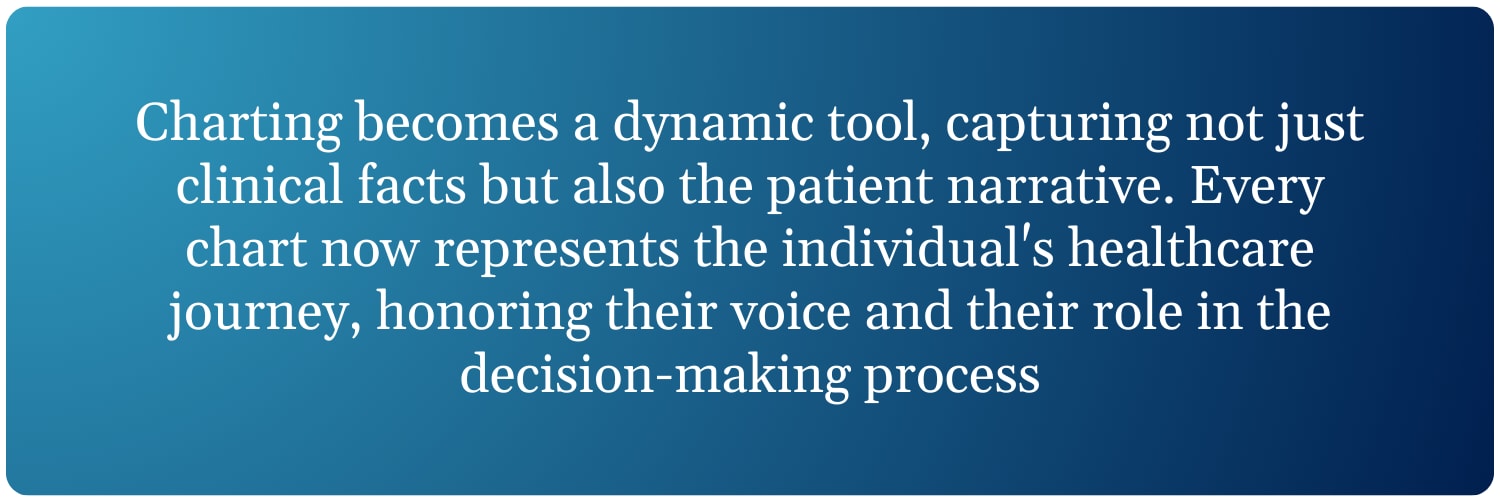The History of Patient Charting

This blog was originally published in June 2022 and was updated in March 2024
While it may seem like a relatively new development, patient charting has been around for centuries. From the early 19th century to the 21st century, the history of medical records mirrors the transformative shifts in medicine, technology, and the very essence of patient-centered care. Keep reading to learn more about the evolution of patient charting from the nineteenth century to today.

Breaking down the history of patient charting
Early forms of patient records
Patient records have been around for over 4,000 years, first used for teaching. Medieval doctors also wrote reports to learn from different cases. Medical records, as we know them, were first developed in Paris and Berlin during the 1800s. However, they only became useful for daily patient care in hospitals and clinics during the 1900s.
Paper-based patient records
By the early 20th century, physicians began to record details of patient visits and medical histories. According to an article published by Rasmussen College, “Documentation became wildly popular and was used throughout the nation after healthcare providers realized that they were better able to treat patients with complete and accurate medical history. Health records were soon recognized as being critical to the safety and quality of the patient experience.”
The importance of recording patient details marks a significant chapter in the history of medical records, leading to the American College of Surgeons (ACOS) standardizing the practice. Adhering to these standards, physicians maintained handwritten patient charts well into the mid to late 20th century, until the advent of new technology began to transform the landscape.
The importance of recording patient details marks a significant chapter in the history of medical records, leading to the American College of Surgeons (ACOS) standardizing the practice. Adhering to these standards, physicians maintained handwritten patient charts well into the mid to late 20th century, until the advent of new technology began to transform the landscape.
The emergence of Electronic Health Records
In the late 20th century, the process of patient charting started to shift to digital platforms. Hospitals and universities were the first to develop and use Electronic Health Records (EHRs). Yet, during the 1980s, there was a focus on getting more medical practices to use EHRs. The Centers for Medicare & Medicaid Services (CMS) acknowledged that despite the error-prone nature of hand-written patient charting and filing, EHRs could enhance patient care by:
- Reducing duplication of tests and delays in treatment.
- Keeping patients well informed to make better decisions.
- Minimizing errors through enhanced precision and clarity of medical records.
Patient charting has advanced significantly in the past 4,000 years. In the 21st century, providers access and share patient data seamlessly through EHRs. The primary care physician is now able to manage care electronically and with precision, guaranteeing the best possible outcomes.
Development of standardized patient charting practices
Today's healthcare providers benefit from a systematized approach to patient charting that integrates seamlessly with EHRs. This not only improves patient outcomes by reducing errors and ensuring clear communication. It also supports healthcare professionals in delivering high-quality care. The primary care physician now operates within a digital ecosystem of secure and readily accessible patient data, keeping the focus on delivering patient-centered care.
Role of health records in clinical coding
Health records are the cornerstone of clinical coding, bringing precision and uniformity to medical charting. They tell the full story of a patient's care journey, which coders then turn into a set of universally understood codes. This coding is vital for clear communication, impacting direct patient care and behind-the-scenes research and planning.
By moving these records into the digital realm with EHRs, patient charting has made a huge leap forward. EHRs provide physicians with precise and current data, ensuring diagnostic, treatment and billing processes are accurate. This has led to improved patient outcomes and streamlined operations in healthcare facilities.
Ultimately, the digitalization of medical charting in EHRs has created a more integrated and intelligent healthcare system.
Factors affecting the extent of patient charting
The extent of patient charting is influenced by several factors, notably the accessibility and usability of electronic medical records (EMRs). In our digitized age, patients' ability to engage with their health records online is empowering, granting them unprecedented access to their health information.
However, this empowerment hinges on the design and functionality of EMR systems. They must be user-friendly to encourage active patient participation. According to research published by the National Center for Biotechnology Information, providing patients with easy access to their EMRs facilitates better understanding and management of their health conditions, leading to improved outcomes.
Moreover, the level of patient charting is significantly affected by the education and resources provided to patients. The more knowledgeable patients are about the benefits and operation of EMRs, the more they are likely to use them actively.
This active use can result in more complete and detailed charting, as patients contribute by providing information on symptoms, medication adherence, and other health metrics. By fostering a collaborative environment where patients and physicians work together, EMRs become a tool not just for documentation but for shared decision-making, ultimately empowering patients in the management of their health.
Patient-centered care and charting
The concept of patient-centered care has reshaped the ethos of healthcare. With a concerted focus, healthcare is focusing on tailoring medical attention to meet the individual needs and preferences of patients. This method is akin to 'patient-focused care.'
The idea of patient-centered care has changed healthcare to focus more on meeting each patient's specific needs and what they want. This method of patient care focuses on tailoring healthcare services to meet individual health needs and goals.
Patient-focused care transcends traditional healthcare delivery, imbuing patient interactions with empathy and personalization. Charting becomes a dynamic tool, capturing not just clinical facts but also the patient narrative. Every chart now represents the individual's healthcare journey, honoring their voice and their role in the decision-making process.
Explore a sample patient chart in Elation EHR
Explore a sample patient chart and see how our EHR's intuitive, easy-to-use features can benefit your healthcare practice.
Impact of patient-centered care practices
Patient-centered care has greatly impacted healthcare, especially in terms of care quality, patient confidence, and trust in providers. A study focusing on cancer patients demonstrates that personalized care creates measurable improvements in the care experience.
Patients reported a higher quality of care, which is a testament to the efficacy of patient-centered approaches. This model not only addresses the physical aspects of treatment but also the psychological and emotional support. Both of these are crucial for patients navigating the complexities of cancer treatment.
Furthermore, the study reveals that patient-centered care enhances patients' confidence in managing their health and strengthens their trust in healthcare providers. When patients feel heard and involved in their care decisions, it builds a foundation of trust. This type of trust is essential for a therapeutic patient-provider relationship.
This deep level of trust is particularly important in the context of a life-altering diagnosis like cancer. During these times, patients must often make complex decisions about their treatment options. By prioritizing the patient's voice, healthcare providers foster an environment of collaboration and support, leading to better health outcomes and a more positive healthcare experience.
Integration of generative AI in patient charting
The healthcare sector stands on the cusp of a transformative era with the integration of Generative AI. It is opening new avenues for enhancing patient care, streamlining workflows, and personalizing medical treatments.
This cutting-edge technology harnesses the power of advanced algorithms to generate new data and insights, which can assist healthcare professionals in decision-making and innovation. This technology is reshaping existing practices and creating novel opportunities for treatment and diagnosis. By presenting a future with more predictive, personalized, and accessible healthcare, the patient experience is being revolutionized once again.
Emerging use cases for generative AI
Generative AI is changing healthcare's handling of medical records through advancements in Natural Language Processing. Its design allows it to parse through the maze of unstructured clinical notes, pinpointing and recording crucial information. This shift is dramatically streamlining EHR maintenance.
With its ability to automate the transfer of information from medical documents into EHRs, AI minimizes the need for manual data entry. Boosting precision and saving precious time for physicians. Moreover, voice-to-text capabilities mean that the spoken word in consultations can be directly transcribed and filed into patient charts with ease.
On the decision-making front, Clinical Decision Support Systems (CDDS) are now powered by AI to offer evidence-based recommendations informed by real-time patient data. This not only assists healthcare providers in making more informed decisions but also elevates the standard of personalized patient care. Predictive analytics, another AI-driven tool, forecasts potential health outcomes, enabling a proactive approach to patient care. By organizing patient charts more effectively, prioritizing urgent cases, and promoting seamless interoperability between diverse healthcare systems, AI is enhancing the overall workflow.
Streamline patient charting with Elation EHR
Elation EHR offers a complete solution for independent and small practice physicians. Unified workflows and intuitive patient charting features make it easier than ever to maximize time with your patients and provide exceptional primary care. Explore a sample patient medical chart today to see how our EHR can benefit your practice.
Transform your Practice with Elation's Clinical-First EHR
Request a Demo to see how our EHR's intuitive, easy-to-use features can benefit your healthcare practice.
The Ultimate Guide to Buying an EHR: A Comprehensive Resource for Healthcare Clinicians
If you're a healthcare provider in the market for an EHR system, check out our comprehensive guide to make an informed decision about the right EHR for your practice.
